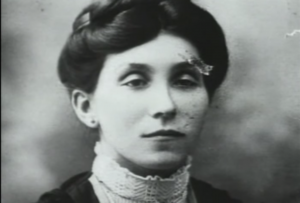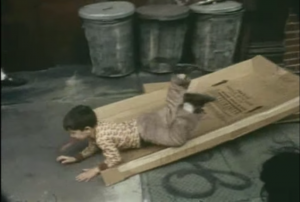In my last article, I called Mean Streets “a home movie with actors,” so it’s only fair that now I’m looking at a home movie without actors. Italianamerican is a brief documentary that appears to have been filmed over the course of a few hours of conversation between Marty and his parents. That may sound a bit dry (and I’ll admit, sometimes it is), but the young Scorsese brings plenty of the tricks he had already shown in his other early films to the table, and the older Scorseses have plenty of personality, especially after Marty puts the footage together with a wonderful observational flair.
He opens the movie by drawing attention to the film medium much like he did at the beginning of Mean Streets and later would at the end of The Last Temptation of Christ. The first image we see is the words “Film Is About to Start,” presumably a built-in feature of the film stock Scorsese used that most filmmakers would snip off before showing their movies in public. It’s appropriate here, though, since the next scene is Scorsese and his film-school buddy Mardik Martin setting up the film equipment in the middle of Charlie and Catherine Scorsese’s living room. Catherine discusses how she and Charlie should pose for the opening shot, wondering why he never seems to sit close enough to her. It’s a moment most documentarians would cut out (and the older Scorsese almost certainly expected him to), but its inclusion here, especially as our first impression of these people, says a lot more than most of what they say when they know the cameras are rolling. Some choice bits of dialogue:
Catherine: Why you sittin’ down there, why? Why you, why is he down there?
Martin: He can do what he wants, let him do what he wants.
Catherine: Get closer.
Charlie: (inaudible)
Catherine: No, you come here. (Charlie stands up and walks closer to Catherine’s side of the couch.) That’s it, that’s more like it! Lovey dovey, sort of, you know. They say as you get older, your love grows stronger. So for some reason, (Gets up and moves right next to Charlie) it is getting a little stronger, you know. Right, daddy? (Charlie looks away and mumbles something) He’s bashful.
It’s a beautiful little scene that could probably never have been scripted, and certainly wouldn’t have fit into a more conventional documentary. The conversation shows the Scorseses very much as a stereotypical old married couple, arguing over little things, (Charlie will have a pretty heated discussion with Catherine later about her “putting on airs” in front of the camera), bored with each other’s company but still putting a high value on public displays of affection. The best moment to me is when Charlie has finally moved into position, and it’s almost like Catherine has finally realized the cameras are rolling. She starts reciting platitudes about how intimate the two of them are, even as Charlie looks deadly embarrassed to be anywhere near here. It’s a scene that fits so well with Scorsese’s work on It’s Not Just You, Murray! and Goodfellas that’s it hard to believe he found it instead of creating it. And when Charlie can’t agree with her, she comes up with an explanation that fits her pre-planned narrative.
In keeping with the project’s title, Catherine lets viewers in on a little slice of Italianamerican culture when she gives them her recipe for marinara (which forms a nice bookend later as the whole thing appears in written form during the credits). The family eventually settles in around the dining room table as Martin’s parents retell stories about the Old Country, and Little Italy, about Catherine’s father having to trick her mother into joining him in America because she was scared of boats, and Charlie and Catherine just recently taking their honeymoon because she was scared of trains. Intercut with all this is archival footage and family photos that create fascinating, very Scorsese-an effects, like the scene where Charlie describes the changes in the street market between his childhood, his adulthood, and now, and the magic of film weaves all the different markets into one seamless point-of-view walk-through.
The home movie aspects of Italianamerican are a huge part of its charm, as we’re invited to join this cozy (if occasionally tense) little family gathering, and Charlie and Catherine get to be themselves, possibly reminding us of our own relatives. I know that was the effect they had on me, and I was grinning like an idiot for big chunks of the film. One of the stories is actually nearly identical to one of mine: when Catherine was a child, her father shaved off his luxurious handlebar mustache one day. When he came home without it, all the children in the family panicked because there was a strange man at the door. Though my dad’s mustache was not quite so magnificent (he’s a lot better off without it), and its disappearance was less of a surprise, I can say our reaction was just about the same. My little sister even cried! Maybe that touches on a major component of the project; as specific Scorsese’s heritage is, and even though it is foreign to many viewers, the documentary shows how many experiences an Italian American family and a Scotch-Jewish(bred for cheapness!)-Cherokee-Spanish-WASP like myself share.
The home-movie charm takes Italianamerican a long way, but unfortunately, it sunk in for me about halfway through that I was just watching someone else’s home movies. Scorsese’s skill keeps this from being as dull as, say, your neighbors pictures of Europe, but the self-indulgent streak that ran through his previous Little Italy pictures is at its peak here, for good and for bad. As much as I’d hate to think of these stories being lost, a twenty-minute version of the same film would have rated a lot higher (and I promise, not every movie in this column will have the same rating).
That said, there’s a lot more to the film than just a dinner with the Scorseses. As the title says, the movie has a lot to say about Italian-Americans in general, dealing with the family’s experiences in the motherland, the immigration process, and the unique and changing face of Little Italy. It was also interesting for me to compare Casa Scorsese to the Hills’ home in Scorsese’s other great Italian-American movie, Goodfellas. That film really impressed me with unglamorous Scorsese’s crew made the rags-to-riches mobster lifestyle, filling the set from top to bottom with gaudy, expensive ridiculousness — wealth without class. Though he came from the same background, Scorsese’s family home is almost opposite from Henry Hill’s — simple and cheap, but just as elegant as the manors in Age of Innocence. They have two beautiful old-fashioned decorative lamps in the background of most shots, several pieces of original art, and the kitchen wallpaper is colorfully kitschy but never tacky. Unlike the later film’s decadent mafiosi, the Scorseses seem to live by William Morris’ advice to “Have nothing in your houses that you do not know to be useful, or believe to be beautiful.” We can look in other films for the origins of Scorsese’s aesthetic, but Italianamerican makes me think he may have learned it home.
You all have the opportunity to decide for yourselves, since the film is available in it entirety at this link, assuming somebody doesn’t decide to get upset that a movie they weren’t making money off of is available for free:
Up next: Scorsese moves out of the neighborhood in Alice Doesn’t Live Here Anymore










